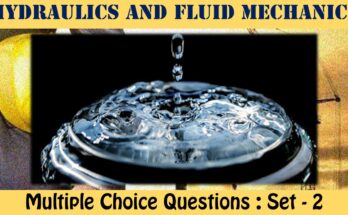MCQ Questions Civil Engineering Design of Steel Structures
The interviewer is almost as nervous as the candidate in most interviews. You might wonder if you look confident enough, if you will hire the right person, or if you are asking the right engineering interview questions. The last question is arguably the most crucial part to worry about when you’re interviewing candidates. Other topics on Civil Engineering Multiple Choice Questions can be accessed
MCQ Questions Civil Engineering Design of Steel Structures - Set - 4
Question 1:
Economical depth of a plate girder corresponds to
a) minimum weight
b) minimum depth
c) maximum weight
d) minimum thickness of web
Correct Answer – (A)
Question 2 :
The overlap of batten plates with the main members in welded connections should be more than
a) 3t
b) 4t
c) 6t
d) 8t
where t = thickness of the batten plate
Correct Answer – (B)
Question 3 :
Battening is preferable when the
i) column carries axial load only
ii) space between the two main components is not very large
iii) column is eccentrically loaded The correct answer is
a) only (i)
b) only (iii)
c) (i) and (ii)
d) (ii) and (iii)
Correct Answer – (C)
Question 4 :
Lacing bars in a steel column should be designed to resist
a) bending moment due to 2.5% of the column load
b) shear force due to 2.5% of the column load
c) 2.5% of the column load
d) both (a) and (b)
Correct Answer – (B)
Question 5 :
If the 20 mm rivets are used in lacing bars, then the minimum width of lacing bar should be
a) 40mm
b) 60mm
c) 80mm
d) 100mm
Correct Answer – (B)
MCQ Questions Civil Engineering Design of Steel Structures
Question 6:
The slenderness ratio of lacing bars should not exceed
a) 100
b) 120
c) 145
d) 180
Correct Answer – (C)
Question 7:
The effective length of a battened column is increased by
a) 5%
b) 10%
c) 15%
d) 20%
Correct Answer – (B)
Question 8:
Angle of inclination of the lacing bar with the longitudinal axis of the column should preferably be between
a) 10° to 30°
b) 30° to 40°
c) 40° to 70°
d) 90°
Correct Answer – (C)
Question 9:
The use of tie plates in laced columns is
a) prohibited
b) not prohibited
c) permitted at start and end of lacing system only
d) permitted between two parts of the lacing
Correct Answer – (C)
Question 10:
The best arrangement to provide unified behaviour in built up steel columns is by
a) lacing
b) battening
c) tie plates
d) perforated cover plates
Correct Answer – (A)
- NCERT Solutions Class 12 Mathematics RD Sharma Sets : Exercise 1.1
- NCERT Solutions Class 12 Mathematics RD Sharma Sets : Exercise 1.2
- NCERT Solutions Class 12 Mathematics RD Sharma Sets : Exercise 1.3
- NCERT Solutions Class 12 Mathematics RD Sharma Sets : Exercise 1.4
- NCERT Solutions Class 12 Mathematics RD Sharma Trigonometric Functions : Exercise – 5.1
- NCERT Solutions Class 12 Mathematics RD Sharma Trigonometric Functions : Exercise – 5.2
- NCERT Solutions Class 12 Mathematics RD Sharma Trigonometric Functions : Exercise – 5.3
- NCERT Solutions Class 12 Mathematics RD Sharma Quadratic Equations : Exercise – 14.1
- NCERT Solutions Class 12 Mathematics RD Sharma Quadratic Equations : Exercise – 14.2
- NCERT Solutions Class 12 Mathematics RD Sharma Linear Inequations : Exercise – 15.1
- NCERT Solutions Class 12 Mathematics RD Sharma Linear Inequations : Exercise – 15.2
- NCERT Solutions Class 12 Mathematics RD Sharma Linear Inequations : Exercise – 15.3
- NCERT Solutions Class 12 Mathematics RD Sharma Linear Inequations : Exercise – 15.4
- NCERT Solutions Class 12 Mathematics RD Sharma Linear Inequations : Exercise – 15.5
- NCERT Solutions Class 12 Mathematics RD Sharma Linear Inequations : Exercise – 15.6
Multiple Choice Questions for Competitive Exams
- Multiple Choice Questions Class 12 Chemistry The Solid State
Set -1 Set -2 Set -3 Set -4 Set -5 - MCQ Questions Class 12 Solutions With Answers
Set -1 Set -2 Set -3 Set -4 Set -5 - MCQ Questions Class 12 Electrochemistry With Answers
Set -1 Set -2 Set -3 Set -4 Set -5 - MCQ Questions Class 12 Chemical Kinetics With Answers
Set -1 Set -2 Set -3 Set -4 Set -5 - MCQ Questions Class 12 Surface Chemistry With Answers
Set -1 Set -2 Set -3 Set -4 Set -5 - MCQ Questions Class 12 General Principles and Processes of Isolation of Elements With Answers
Set -1 Set -2 Set -3 Set -4 Set -5




